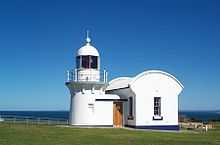Crowdy Head Light
 | |
| Crowdy Head Light, 2008 | |
 | |
| Location | Crowdy Head, New South Wales, Australia |
|---|---|
| Coordinates | 31°50′36.32″S 152°45′12.79″E / 31.8434222°S 152.7535528°ECoordinates: 31°50′36.32″S 152°45′12.79″E / 31.8434222°S 152.7535528°E |
| Year first constructed | 1878[1] |
| Automated | 1928 |
| Foundation | concrete slab |
| Construction | stone |
| Tower shape | round, lantern, gallery |
| Markings / pattern | white |
| Height | 24 feet (7.3 m) |
| Focal height | 201 feet (61 m)[2] |
| Original lens | 4th order fixed catadioptric |
| Intensity | 28,000 cd |
| Range | 16 nautical miles (30 km) white 13 nautical miles (24 km) red |
| Characteristic | two white flashes, separated by 2s, every 10s red flashes to northeast. |
| Admiralty number | K2784 |
| NGA number | 111-6028 |
| ARLHS number | AUS-062 |
Crowdy Head Light is an active lighthouse located at Crowdy Head, a headland between Forster and Port Macquarie, New South Wales, Australia. It is registered with the Register of the National Estate.
History
The first station in the area was a pilot station established in 1860 at nearby Harrington, assisting ships navigating the entrance of the Manning River.

The current lighthouse is the last of five lighthouses of similar design designed and built by James Barnet in 1878-80, the other four being Fingal Head Light, Clarence River Light (now demolished), Tacking Point Lighthouse and Richmond River Light. The original light was a fixed white light from a 4th order catadioptric apparatus with an intensity of less than 1,000 cd. It was manned by one keeper.
In 1928 the apparatus was converted to a carbide lamp (acetylene gas), with an intensity of 1,500 cd. At the same opportunity the light was automated.
The pilot station was closed in the 1960s. In 1972 the light was converted to mains electricity.
In 2002 the 4th order Fresnel lens was sold on eBay in 2002 for $20,000, and is now on display at Sea Girt Light in New Jersey.[3]
Structure

The circular tower is capped by an oversailing bluestone platform supported by shaped bluestone corbels. It can be reached by a metal stair from the concrete slab which forms the ground floor and foundation for the buildings. The tower walls of stone bricks taper off from a thickness of 19 inches (480 mm) at the base to 14 inches (360 mm) at the top.
A porch, roofed just above door height, connects the tower to a rectangular annexe, which originally contained a duty room for the keeper and a store for fuel
All the external walls of the structure are cement rendered and painted white. The platform is surmounted by a simple metal domed lantern which encloses the optical apparatus. A handrail at the platform perimeter is of white painted cast iron standards with wrought iron rails.
Site operation
The light is managed by Roads and Maritime Services (formerly NSW Maritime),[4] while the site is managed by the New South Wales Department of Lands.
Visiting
The grounds of the lighthouse are open, but the tower is closed.
See also
| Wikimedia Commons has media related to Crowdy Head Light. |
Notes
- ↑ RNE3496 states 1879, which might be more accurate as it is the last of the five small lighthouses.
- ↑ According to all sources except the RNE3496 which states 62 m.
- ↑ "Sea Girt Lighthouse, New Jersey at Lighthousefriends.com". lighthousefriends.com. Retrieved 30 August 2010.
- ↑ According to NSW Maritime, though Rowlett says Australian Maritime Safety Authority.
References
- List of Lights, Pub. 111, The West Coasts of North and South America (Excluding Continental U.S.A. and Hawaii), Australia, Tasmania, New Zealand, and the Islands of the North and South Pacific Oceans (PDF). List of Lights. United States National Geospatial-Intelligence Agency. 2009. p. 123.
- Rowlett, Russ. "Lighthouses of Australia: New South Wales". The Lighthouse Directory. University of North Carolina at Chapel Hill. Retrieved 2010-08-29. Listed as "Crookhaven Head".
- "The Crowdy Head Lighthouse". Lighthouses of New South Wales. Lighthouses of Australia Inc.
- Searle, Garry. "Crowdy Head". Lighthouses of New South Wales. SeaSide Lights.
- "Crowdy Head Lighthouse (listing RNE3496)". Australia Heritage Places Inventory. Department of Sustainability, Environment, Water, Population and Communities. Retrieved 30 August 2010.
- "Lighthouse Lights - NSW Maritime". maritime.nsw.gov.au. Retrieved 3 October 2010.
| ||||||||||||||||||||
